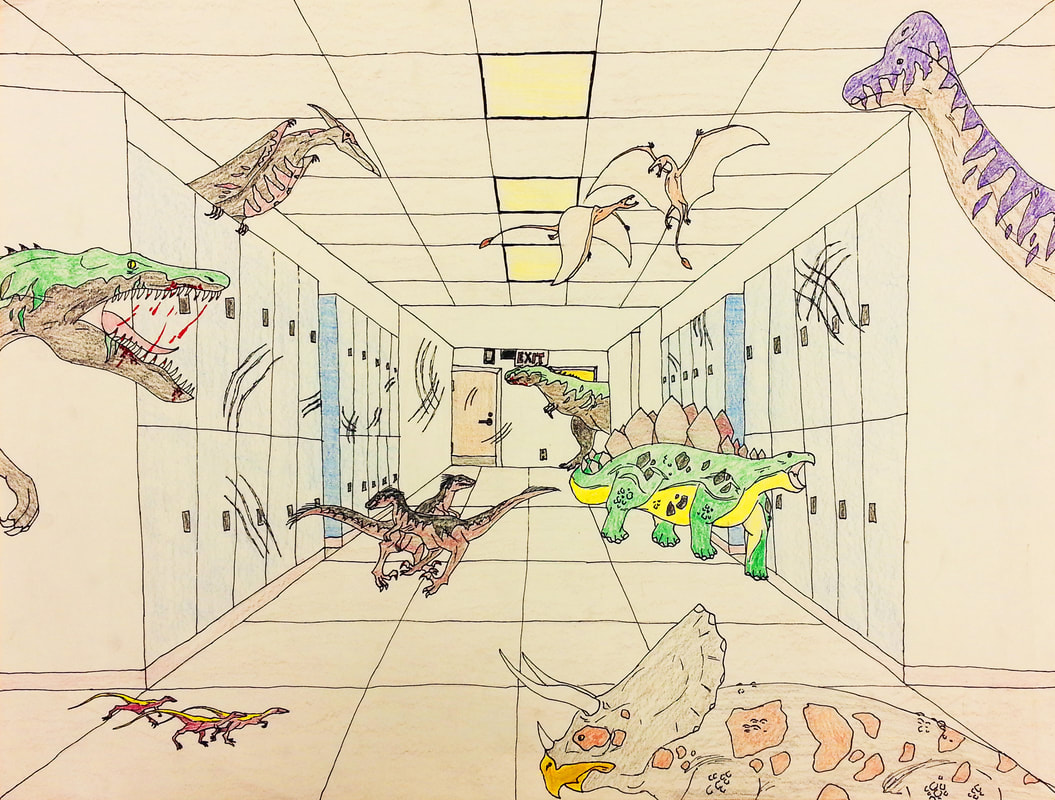Engaging all student from talented to challenged in the same class. Art teacher Amanda asks, “…I have a drawing class of about 15 kids. About half the class has super high talent. They turn in great work … the...
Engaging all student from talented to challenged in the same class.
Art teacher Amanda asks, “…I have a drawing class of about 15 kids. About half the class has super high talent. They turn in great work … the other half works fast, and their work is below average ability level for high school. Of course, I redirect, ask them to add details, refine etc. They almost always finish WAY before the other group. What suggestions do you have? More practice work for early finishers?”
Though it feels like Amanda is asking for some scaffolding help, I think some pre-work foundations may be really helpful. I find that when students rush, it’s because they are skipping really important pre-work. As an art teacher, I know my students get excited to “make stuff” but often jump in without planning.
When I write my lessons, I identify the main thing I want my students to learn or demonstrate. For example, in a perspective lesson, we draw a hallway in one-point perspective and add surreal elements.
My learning target is for students to use one point perspective with traditional drawing tools. I require that their drawing includes doors, lockers, and ceiling/floor tiles. I walk them through the process and provide video resources to demonstrate all 3 perspective drawing techniques. No matter how “good” the drawing is, if it includes these three items, I will assess a passing grade of at least 70%. That is my base, or “ground floor.” But how do we get there and avoid the tendency for students to rush? And what do you do so that your more advanced students can be meaningfully challenged?
Though it feels like Amanda is asking for some scaffolding help, I think some pre-work foundations may be really helpful. I find that when students rush, it’s because they are skipping really important pre-work. As an art teacher, I know my students get excited to “make stuff” but often jump in without planning.
When I write my lessons, I identify the main thing I want my students to learn or demonstrate. For example, in a perspective lesson, we draw a hallway in one-point perspective and add surreal elements.
My learning target is for students to use one point perspective with traditional drawing tools. I require that their drawing includes doors, lockers, and ceiling/floor tiles. I walk them through the process and provide video resources to demonstrate all 3 perspective drawing techniques. No matter how “good” the drawing is, if it includes these three items, I will assess a passing grade of at least 70%. That is my base, or “ground floor.” But how do we get there and avoid the tendency for students to rush? And what do you do so that your more advanced students can be meaningfully challenged?
Let’s minimize the rushing issue first…
I will require a thumbnail sketch. It might take the form of a blank hallway hand-out where students do doors, lockers, and tiles with a ruler, T-square, or other tools I want them to use. When they show me the sketch, I assess it, ask for re-works, or approve it. I then allow them to work on final paper to do the hallway drawing. They see me again for approval, and go back to their sketch and work out ideas for surreal elements that follow the rules of perspective. That again is shared with me for approval, and they can add their surreal elements to their final drawing. When students rush, it tells me that they need more frequent check-ins; AKA, more foundation work. This might be tedious, but even your advanced students will benefit.
As students become more familiar with your expectations, you can do check-ins less formally by looking over their shoulders and giving them the okay to move forward when you see they are incorporating the depth you are hoping for.
How do we keep more advanced students engaged? I let students know what they need to do to meet expectations (70%) and then list what they can do to exceed expectations to earn a higher grade (90%+). For this assignment it might look like this:
Meet expectations (70%) with:A hallway that includes a door, set of lockers, and tiles following the rules of perspective.All lines drawn with a ruler & T-squareSurreal element(s) in the hallway that follow the rules of perspective.
Exceed expectations by:Adding additional observed items in the hallway in perspective. (vents, water fountains, trash cans, posters, display cases, windows, etc…)Having multiple surreal elements in perspectiveIncorporating textures and shadows that demonstrate an attention to detailIncluding stipple/crosshatchingIncorporate other techniques you learned in class
Stopping all work periodically for peer check-ins can also be helpful. I will often do a mid-project critique that can help students re-focus.
If behavior is an impediment to success, then re-work your seating charts. I have mixed classes with 9th through 12th graders. I will often put a senior next to a freshman because their presence will cut down on immature behavior. Putting talented students with peers who struggle can be helpful too. The advanced students can almost operate as a student-teacher, but their work can often inspire the work of the poor performing peer.
If students are not doing well because they are distracted or not working, include a time-on-task element to your grading rubric. I grade my student’s “participation” through my “Studio Habits” grade. They know that if they are off task, it will be recorded. Those who finish early know they must stay engaged in the art making process. To that end, I have 180 sketchbook prompts they can choose from if they finish early. They know that if they rush, they will not be rewarded with “free time.”
If you have found this helpful, I have written a whole book based on my pedagogy of teaching art. You can find it on Amazon HERE. If you are looking for differentiated lessons for all levels of skill, THIS may be a helpful resource.
I will require a thumbnail sketch. It might take the form of a blank hallway hand-out where students do doors, lockers, and tiles with a ruler, T-square, or other tools I want them to use. When they show me the sketch, I assess it, ask for re-works, or approve it. I then allow them to work on final paper to do the hallway drawing. They see me again for approval, and go back to their sketch and work out ideas for surreal elements that follow the rules of perspective. That again is shared with me for approval, and they can add their surreal elements to their final drawing. When students rush, it tells me that they need more frequent check-ins; AKA, more foundation work. This might be tedious, but even your advanced students will benefit.
As students become more familiar with your expectations, you can do check-ins less formally by looking over their shoulders and giving them the okay to move forward when you see they are incorporating the depth you are hoping for.
How do we keep more advanced students engaged? I let students know what they need to do to meet expectations (70%) and then list what they can do to exceed expectations to earn a higher grade (90%+). For this assignment it might look like this:
Meet expectations (70%) with:A hallway that includes a door, set of lockers, and tiles following the rules of perspective.All lines drawn with a ruler & T-squareSurreal element(s) in the hallway that follow the rules of perspective.
Exceed expectations by:Adding additional observed items in the hallway in perspective. (vents, water fountains, trash cans, posters, display cases, windows, etc…)Having multiple surreal elements in perspectiveIncorporating textures and shadows that demonstrate an attention to detailIncluding stipple/crosshatchingIncorporate other techniques you learned in class
Stopping all work periodically for peer check-ins can also be helpful. I will often do a mid-project critique that can help students re-focus.
If behavior is an impediment to success, then re-work your seating charts. I have mixed classes with 9th through 12th graders. I will often put a senior next to a freshman because their presence will cut down on immature behavior. Putting talented students with peers who struggle can be helpful too. The advanced students can almost operate as a student-teacher, but their work can often inspire the work of the poor performing peer.
If students are not doing well because they are distracted or not working, include a time-on-task element to your grading rubric. I grade my student’s “participation” through my “Studio Habits” grade. They know that if they are off task, it will be recorded. Those who finish early know they must stay engaged in the art making process. To that end, I have 180 sketchbook prompts they can choose from if they finish early. They know that if they rush, they will not be rewarded with “free time.”
If you have found this helpful, I have written a whole book based on my pedagogy of teaching art. You can find it on Amazon HERE. If you are looking for differentiated lessons for all levels of skill, THIS may be a helpful resource.












